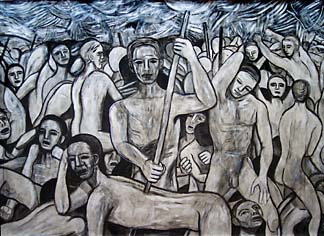
Current Issue Highlights More Readings DA Home About Direct Art
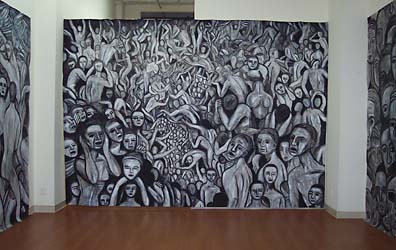 Inside The War Room
by Diana Ayton-Shenker
Inside The War Room
by Diana Ayton-Shenker
Inside The War Room, you can’t look away. The War Room, William T. Ayton’s four-wall, painted installation, surrounds the viewer with stark, monochromatic images that explore and expose the human faces and consequences of war. Depicting four fundamental aspects of war: Warriors, Victims, Witnesses and The Aftermath, the installation compels viewers to confront themselves as they identify with and are moved by provocative, poignant figures that animate the wall-sized panels.
The impetus for The War Room came when a tapestry of Picasso’s famous anti-war painting, Guernica, was covered up as the backdrop for a Colin Powell press conference at the U.N. (February 5, 2003) leading up to the Iraq conflict. As an artist, Ayton was outraged by this censorship, and quickly responded with the concept and initial sketches for his own epic, anti-war piece that would, by its very nature, be difficult to cover up or ignore. "I knew I had to do something," says Ayton. "The War Room is my statement." The installation gives testament to the potency of one artist’s vision, and the importance of artistic freedom, especially during war time.
Partly as a tribute to Guernica, The War Room’s four panels are painted in black-and-white, with other references embedded within, such as a half-hidden horse in the Warriors panel alluding to Picasso’s symbol for human nobility and vulnerability. The installation also pays homage to other artists and their treatment of the human condition, whether related to war or not. Goya’s Horrors of War etchings, his black paintings, and various works by El Greco and Velazquez serve as indirect influences, as well as many others from fine art and popular culture. One commentator mentioned a resemblance between the Witnesses panel — using a montage of disembodied heads, and the work of comic-book artist, Steve Ditko. Another saw resemblance to an Abu Ghraib photograph in the Warriors panel (though the artwork was conceived and developed nearly a year before the notorious photographic images were circulated). Throughout the installation, there are many references to other art works and visual iconography, both intended and unintentional.
THE WAR ROOM PANELS
The Warriors — this panel reflects the naked savagery of war. While inspired initially by events leading up to the Iraq war, the intention is to transcend the specifics of the current conflict to convey a more universal depiction of warriors. Particular uniforms or weapons are avoided; these could be combatants from any war. The central figure impales his victim with a spear-like tool. The other figures are caught up in the mayhem of violence and struggle. There is no sense of who is on which side — the fight devolves into a vortex that sucks in everyone. To avoid the danger of glorifying war, the panel is viewed in juxtaposition to those depicting victims and witnesses.

The Witnesses — a mass of silent heads, gathered together in judgement, prayer, silent observation, outrage or ignorance. The figures represent a wide array of reactions to war. Some of the witnesses are blindfolded or masked; others seem to penetrate the viewer with their piercing gaze, stare into the eyes of the warriors in the opposing panel, or simply look away. Some of the witnesses may also be warriors, or victims. After awhile, the distinctions start to blur and interrelationships emerge between the witnesses, victims and warriors.
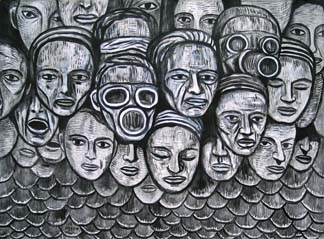
The Victims — another vortex, this time of souls as they spiral both upward and downward. In fact, it’s not clear if these are the dead, the physically wounded, or the spiritually wounded. The sense here is that we are all victims of war. There’s an ambiguous, but irrepressible movement of figures in ascension and descent, cascading into each other, overwhelmed by the tumultuous forces that overtake them. Amidst the chaos and despair, there are moments of human tenderness, resistance and resilience.
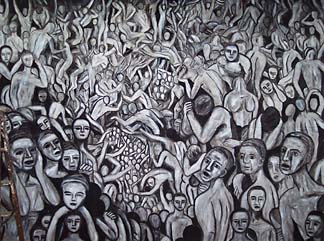
The Aftermath — here, all is in ruins. War has taken its toll and all that remains are bits of war machinery, fragments of masonry and suggestions of body parts. The end of war is a desolate wasteland, devoid of human life or civilization. Perhaps new civilizations will arise from the rubble; perhaps they won’t. A sliver of hope lies in the opening of The Aftermath panel, through which the viewer can glimpse the real world s/he has just left to enter the realm of The War Room. Exiting through this same opening, viewers re-enter the world outside The War Room with a profound sense of war’s inhumanity and a renewed sense of hope upon leaving its insanity behind.
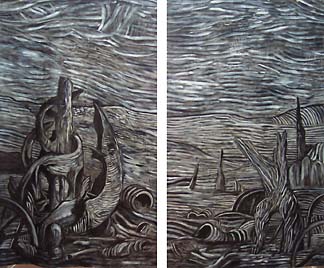
WAR ROOM IN NEW YORK
Last year, The War Room had its world premiere with two room-sized versions of the installation exhibited concurrently (August - October 2004) in New York. One installation was shown in New York City (at chashama’s new mid-town gallery and featured as part of the Imagine ’04 Citywide Festival of Arts, Issues & Ideas); the other in Poughkeepsie, NY (at The Albert Shahinian Gallery of Fine Art, with support from the Dutchess County Arts Council). In addition, related works and preparatory studies for The War Room have been shown in galleries and online (The Limner Gallery, Phoenicia, NY; Gallery 218, Milwaukee, WI; The Gallery at the Warehouse, Washington D.C., and an online exhibition curated by WNYC). The War Room was awarded fiscal sponsorship of the New York Foundation for the Arts.
The public response has been tremendous with visitors expressing cathartic relief, anguish and gratitude to experience such a moving and powerful art installation dealing with the human dimension of war. The War Room attracted around 1000 visitors and extensive media coverage, including reviews and mentions in The New York Times, The Boston Globe, The Wall Street Journal, The Poughkeepsie Journal, Chronogram, and Theatre2k.com.
The New York City installation generated considerable attention as its opening coincided with the 2004 Republican National Convention (and related opposition protests) which took place just a few blocks from the gallery. In this politically charged atmosphere, people were espec ially struck by the capacity of Ayton’s War Room to rise above the constraints of political platforms, reaching people through power of art. In addition to those who came to experience the installation itself, The War Room drew significant audiences for two standing-room only, literary events: a dramatic reading selected from War Letters edited by Andrew Carroll, and a poetry reading featuring Sharon Olds, Quincey Troupe, Luc Sante, Karen Swensen and Eliot Katz. The poetry reading and interviews wi
Plans to schedule future installations are underway for the two existing versions (one comprises a room of four 10' h. x 16' w. panels; the other has four panels approximately 8' h. x 12' w. ); and opportunities are also being sought for additional versions. Ayton’s original vision was to create a room with four panels similar in dimension to the Guernica (approximately 12' h. x 25' w.). "Then," Ayton says, "the circle would be complete."
To view images and read more about the project, visit www.warroomproject.org
Diana Ayton-Shenker
has written extensively on culture and politics; her most recent book is A Global Agenda: Current Issues Before the United Nations. The curator of The War Room, she has collaborated with her husband William T. Ayton on several international art projects about human rights and peace. Ms. Ayton-Shenker has worked with the United Nations, taught at colleges and universities in New York and Paris, and currently runs the consulting firm Global Momenta.Current Issue Highlights More Readings DA Home About Direct Art